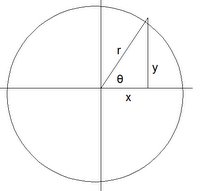Wolfram's MathWorld web site has a wonderful graphic that demonstrates this:

Here's the reason that it's true:
Theorem: The N-th Roots of Unity correspond to n points evenly dividing up a circle
Proof:
(1) The number of radians in a circle is 2π [See here for review of radians, if needed]
(2) The equation for roots of unity is (see Corollary 1.1, here):

where 0 ≤ k ≤ n-1.
(3) So each root of unity is:
cos[ (2kπ)/n] + isin[(2kπ)/n]
where 0 ≤ k ≤ n-1
(4) Which is the same as:
cos[(k/n)2π] + isin[(k/n)2π]
where 0 ≤ k ≤ n -1
(5) Now, complex values can be graphed on the Cartesian coordinate system on x + iy [this is called the complex plane].
(6) Each of the roots above maps to a point on the circumference of a unit circle since:
(a) The equation for a unit circle at (0,0) is [See Theorem 1, here]:
x2 + y2 = 1
(b) Since we are mapping cos[(k/n)2π] + isin[(k/n)2π] to x + iy, this gives us:
x = cos[(k/n)2π]
y = sin[(k/n)2π]
(c) From a previous result (see Corollary 2, here), we have:
cos2[(k/n)2π] + sin2[(k/n)2π] = 1
(d) So, applying step #6b above gives us:
x2 + y2 = 1
(7) So, all we have left to prove is that each of these n points is equidistant from the adjacent points on the circle.
(8) Clearly, we have points at based on the following n values:
(0/n)2π, (1/n)2π, (2/n)2π, ..., [(n-1)/n]2π
where
y = cos[(k/n)2π]
x = sin[(k/n)2π]
(9) Now, if we use a unit circle, it is clear that each of these points is equidistant from each other since:
Consider a circle which has the radius r = 1.
It is clear that plotting lines at (0/n)2π, (1/n)2π. ... ([n-1]/n)2π divides up the total circle (2π radians) into n equal portions.
Using a unit circle, it is clear that x=[cos(k/n)2π] and y = [sin(k/n)2π] are the places of intersection when the circle is evenly divided since:
sin θ = y/r = y
cos θ = x/r = x

In other words, each y=cos[(k/n)2π] and x=sin[(k/n)2π] is a point at the place where the (k/n)th part of the circle sweeps out against the circumference of the circle.
Since the length of the circumference is πD=(2r)πr = 2(1)π, [see Corollary 1, here], this means that the length of each subtended arc is (k/n)*2π.
This results in the patterns above depending upon the value of n.
QED
For example, if we graph the third roots of unity. Then, we have:
lines sweeping out at:
0, (1/3)2π, and (2/3)2π.
which results in the following graph:

References
- Rowland, Todd and Weisstein, Eric W. "Root of Unity." From MathWorld--A Wolfram Web Resource. http://mathworld.wolfram.com/RootofUnity.html
- "Complex Plane", Wikipedia.com
- "Roots of Unity", Wikipedia.com
2 comments :
Wow! This is brilliant.... I just don't have words for it Larry. You are doing a wonderful job here. How come you manage to produce so many cool proofs man! I doubt you are a SW Engg. or Mathematician. Actually I stumbled upon your blog on search of a good explanation and proof for binomial theorem! But I was surprised to find everything in here, including math refresher. Thanx a lot man. Thats really a heck of a job you are doing. I myself is SW Engg. but never had a edge on math through out my life, I decided recently to give it another try so that I start loving it and and may be can write proofs like you :-). Do you have any suggestions?
Hi Nataraj,
Thanks very much for your comments! :-)
I am also a Software Engineer by profession.
Based on your write up, I don't really have any suggestions. It sounds like you are on your way.
Cheers,
-Larry
Post a Comment